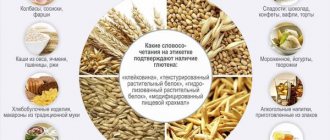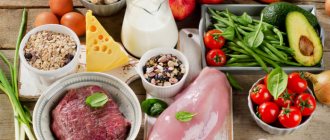First, let's look at what is a potential threat to our health and what gluten is. This is an elastic protein, what remains after the starch is washed out from wheat flour. It is found in cereals and all the products they contain - fluffy and rosy buns, rolls. Gluten is a gray mass that sticks to your hands. It is often added to all kinds of sweets - cookies, candies, ice cream. It is found in pasta and many drinks.
If a person has no health complaints, donuts and buns eaten in reasonable quantities will not cause him harm. But some people have gluten intolerance or an allergy to it. What is this? Let's figure it out in order.
What is gluten?
Gluten is a plant protein (gluten) found in wheat, barley, oats and rye. It got its name from the Latin word “gluten”. Gluten is used to make bread because it has elastic properties, makes the dough sticky and traps carbon dioxide bubbles inside. Gluten is a grey, sticky substance that has no taste.
Compound and chemical formula of gluten
Once inside the stomach, gluten settles on the walls and slowly breaks down.
However, during this time, gluten has a negative effect on the digestive system. The protein sticks together the villi located on the walls of the stomach, which interferes with the absorption of nutrients. It also impairs the digestion process. Interesting fact : approximately 1% of people on the planet are gluten intolerant, and their body is not able to digest this type of protein.
Celiac disease: what it is and symptoms in adults
Another name for the disease is celiac enteropathy. This is an autoimmune hereditary disease of a chronic nature, as a result of which the villi in the small intestine are destroyed by proteins (gluten).
This leads to atrophy of the small intestine and impaired absorption of fat and carbohydrates.
Celiac disease can develop in a person who has consumed grains throughout his life. Until then, she goes through it secretly. Pathology is an inflammatory process in the small intestine. To diagnose it, blood and stool tests, skeletal x-rays and intestinal histology are done.
The genesis of the disease is heredity and autoimmune factor. Therefore, the following factors can be identified that led to the disease:
- genetic predisposition;
- frequent stress;
- the presence in the patient’s diet of a large number of products that contain gluten;
- body shake;
- pathological diseases of the liver and stomach;
- insufficient amount of secreted Chymotrypsin, Pepsin and Trypsin;
- viral intestinal infections.
Celiac disease in adults is caused by protein in grains. Most often, one of the family members suffers from it. The herpes virus is almost always found in patients.
Depending on the type of disease, the symptoms of the pathology can be of a different nature and affect different systems of the body. With celiac disease, patients experience the following unpleasant symptoms:
- severe abdominal pain, flatulence and the release of strong-smelling gases;
- the stool becomes unstable, and diarrhea, in which the stool foams heavily, is more common; stool turns gray or light in color;
- when analyzing for dysbacteriosis, there are no pathogenic microflora in the stool, despite obvious symptoms of the predominance of pathogenic bacteria; There may be a complete lack of appetite;
- the patient begins to rapidly lose weight; from time to time nausea occurs, which can turn into vomiting;
- since fats are poorly digested, stool becomes greasy and is difficult to wash off; Taking into account the deterioration of the patient’s condition, the abdomen begins to noticeably increase, the mucous membranes become bright.
Often there is an accumulation of fluid in the small intestine, which further increases the volume of the abdomen.
Multivitamin deficiency leads to severe dryness and flaking of the skin, teeth begin to decay, stomatitis may appear, and nails and hair suffer.
In some cases, due to impaired absorption of substances necessary for the body, patients experience severe swelling of the lower extremities, and bones can break without serious mechanical impact.
Harm and benefit
When gluten enters the stomach, a special enzyme is responsible for its breakdown. And if it is not produced in the body in the proper quantities, part of the protein will not be absorbed. This will gradually lead to gluten intolerance, which will result in serious digestive problems.
Unfortunately, if the body does not absorb gluten, it cannot be corrected. It is advisable for a person to completely avoid foods containing gluten. If, when consuming such food, abdominal pain, bloating and other discomfort appear, then most likely the stomach does not cope well with the absorption of these proteins. You can find out about gluten intolerance by taking appropriate medical tests.
Bread contains large amounts of gluten
There is an opinion that gluten contributes to excess weight gain. But in fact, a person’s weight grows not because of this substance, but because of the products themselves. It turns out that gluten is found in foods that are high in calories. Baking, bread, sweets - all this leads to weight gain.
And replacing gluten-containing foods with gluten-free ones does not always help you lose weight. The problem is that gluten-free alternatives are supplemented with fats and other high-calorie additives.
There are no benefits from gluten as such, but it helps to achieve a positive effect when preparing foods. For example, without gluten, bread would not be as fluffy and soft. Gluten is also added to ketchup and yogurt to give the product viscosity and thickness.
Interesting: Doppler effect - description, photo and video
The harm of gluten
Wheat, rye, and barley have been grown for centuries. In recent decades, modern varieties of cereals have been developed through selective breeding. They are unpretentious and high-yielding. But they contain gluten, which goes into products. When broken down in the intestines, they form larger molecules than traditional cereals.
They are more difficult to completely digest and require excellent stomach and intestinal health and the production of sufficient enzymes.
Thus, gluten requires a lot of effort from the body to process. Their deficiency causes the accumulation of gluten, which disrupts the functioning of the digestive system - a common cause of obesity.
Incompletely digested gluten and its excess irritate the intestinal villi, causing increased permeability of its walls and inflammation of the gastrointestinal tract.
Over the past 30-40 years, gluten sensitivity and intolerance have increased significantly.
Switching to gluten-free products restores the gastrointestinal mucosa.
Application
Gluten is widely used in the baking industry. Thanks to its properties, it makes baked goods voluminous and elastic. Gluten is added to flour because thanks to it it acquires properties that meet the established quality standards. When gluten is mixed into the dough, the latter absorbs more water. Thanks to this, the structure of the substance improves, the density increases and the shelf life of the product increases.
Dry gluten
Fun fact : Gluten is used to make pasta, which makes it soft and elastic when cooked.
Gluten is often added to those types of products that, as a result of cooking, should become sticky and viscous. The substance is necessarily used in the production of ketchups, ice cream and sauces.
Before making semolina, the manufacturer measures the gluten level in the wheat grain used. If its content is too low, the cooked porridge will turn out dry and grainy.
In its pure form, gluten is used in oriental cuisine. Vegetarian and vegan dishes are prepared with it.
Does beer have gluten?
Undoubtedly, you can be a passionate fan of the foamy drink and care about your health. Therefore, the reasonable question about gluten in beer - what it is, and whether it really makes your favorite drink dangerous for the body - occupies certain minds. The fact that the properties of gluten significantly enhance the taste of food, and the specific chemical structure makes this protein an excellent preservative, does not at all indicate its benefits.
Beer production is impossible without the use of gluten - in beer it acts as a preservative, but in fact cannot cause serious harm unless a person suffers from individual protein intolerance. There is an opinion that myths about gluten in beer are just a marketing ploy: its main goal is to artificially increase the demand for gluten-free beer. Perhaps gluten-free beer is also not so harmless: having lost a natural preservative, which also improves the taste of the drink, it becomes necessary to supplement it with artificial flavor enhancers.
The price category of gluten-free beer is not cheap, and the real benefits of such a product are questionable
Intolerance (Celiac disease)
A disease in which the body cannot digest gluten is called celiac disease. The disease disrupts the functioning of the small intestine and manifests itself at any age. Moreover, in children it is diagnosed almost immediately, but in adults the initial symptoms can be barely noticeable for several years.
If a person has celiac disease, then he is strictly forbidden to eat wheat, barley and rye. It is also necessary to follow a gluten-free diet, otherwise in a few years this could lead to the most dire consequences.
Interesting fact : there is no cure for celiac disease; the only way to prevent the disease is to avoid foods containing gluten.
One of the symptoms of celiac disease is abdominal pain.
Gluten intolerance can be caused due to changes in the intestinal microflora, which causes the body to lose the ability to absorb it. Also, gluten sometimes breaks down before it enters the stomach if certain types of bacteria are present in it. They break down gluten into components that cause irritation to the digestive tract. However, gluten may also contain beneficial bacteria that increase the body's immunity.
There are two ways to diagnose celiac disease: undergo appropriate tests or exclude foods containing this substance from your diet. If doctors diagnose a disease, the patient is prescribed a special diet.
Gluten is not an essential substance for humans and can be replaced by other proteins found in buckwheat, rice and corn. It is also still unknown whether oats can be consumed during the diet. Previously, it was believed that it had a bad effect on the body of people with gluten intolerance. But modern research shows that they can still eat dishes made from it.
Interesting: Sweet potato: what is it, description, what it looks like, where it grows, varieties, photos and videos
Hello marketers
But where and why did the opinion about the benefits of a gluten-free diet for all humanity suddenly arise? Is this really the case when smoke appeared without fire? And here's where it comes from.
Celiac disease, as already mentioned, is rare in its classical form. In most patients, this disease is detected “unexpectedly” - the patient goes to the doctor with complaints of severe itching of the skin, accompanied by weight loss, or increased fatigue, and suddenly finds out that it’s all about gluten, which is poison for his body. Patients with completely different complaints suddenly found out that the cause of their illness was the same - eating gluten-containing foods...
As a result, the following happened.
First, there was a demand for gluten-free food products (as well as medicines). Demand, as we know, gives rise to supply, that is, the production of a sought-after product, and any manufacturer is ready to do anything to increase sales of its products.
Secondly, nutritionists joined in with new diets. Any diet brings its author (its authors) an income that is generally comparable to the income of producers of certain food products. Books and articles, seminars, webinars... As a result of these factors, the last two words miraculously dropped out of the statement “Foods containing gluten are harmful for people with celiac disease.” And off we go...
What does it contain?
Products containing gluten
The main sources of gluten are cereal plants: rye, barley and wheat, and dishes in which they are used as ingredients. Gluten is also found in couscous, bulgur, semolina, malt, spelled and kamut.
Interesting fact : some grains do not contain gluten - amaranth, quinoa, rice, millet, sorghum, corn and buckwheat. They are recommended for use by people on a gluten-free diet.
In order not to accidentally purchase a product containing gluten, you need to carefully study its packaging. The manufacturer is required to leave a corresponding note if this substance is present in the composition. Some products are also labeled “may contain gluten.” This does not guarantee that they actually contain gluten. It just might have gotten into the composition during the creation process, and the manufacturer is obliged to warn customers about this.
It's all about the gluten
Andrey Sazonov
general practitioner
Let's remember what gluten is. This is gluten, sticky proteins that are found in the grains of cereal plants, especially in the grains of rye, wheat and barley. Please note that “gluten” is not the name of a specific substance (protein), but a concept that unites a group of proteins that have similar properties. Many people believe that gluten is only found in bread and flour products. But no, it is present in various products and dishes. Did you fry a spoonful of flour in oil and add it to the soup to thicken it? Congratulations - you now have gluten-containing soup. If flour is added to dishes according to a recipe, then to food products - to give them more volume or a solid shape. Almost a third of all food products on sale contain some amount of gluten. You can try for a long time and unsuccessfully to lose excess weight, suffer from headaches or, for example, iron deficiency anemia, constantly be in a state of depression, complain of poor memory and... And not know that gluten is to blame for all this!
Modern research has proven that gluten, which has been consumed not even for centuries, but for millennia, increases the risk of a large number of diseases - cancer, cardiovascular, autoimmune, neuropsychiatric, endocrine. Also, eating gluten is the cause of most diseases of the digestive system.
What is gluten-free?
The gluten-free label refers to products in which gluten is completely absent or its concentration is below a certain value. If a manufacturer wants special labeling on the packaging of its products, it needs to send it for inspection.
Based on the results of an analysis of the composition and its components, the product is assigned one of three statuses:
- “Gluten free” if there is less than 20 mg of gluten per kilogram of product, or it is absent altogether;
- “Product with low gluten content” - this marker is placed on products in which the amount of the substance does not exceed 100 mg per kilogram;
- if gluten is present in a product in greater quantities than the established norm, the manufacturer will be obliged to notify the buyer about this.
You can find out what type the product belongs to thanks to the corresponding mark on the packaging.
Gluten-free diet
As more and more people try to live a healthy lifestyle and stop eating unhealthy foods, the gluten-free diet is gaining popularity. It is prescribed to a person who cannot digest gluten. As part of it, he must completely get rid of products that contain gluten and find analogues for them.
Foods you can eat on a gluten-free diet
Some people believe that a gluten-free diet can be beneficial even if the body is able to digest this type of protein. However, there is no official confirmation that it is useful in any other cases. Before starting a gluten-free diet, you should consult your doctor.
Some people may experience health problems as a result of abruptly avoiding gluten-containing foods. There is a risk of rapid accumulation of excess weight, and the appearance of fiber and nutrient deficiencies. The likelihood of developing cardiovascular diseases increases. Therefore, when excluding products, analogues should be carefully selected. It is important to regularly provide the body with an influx of vitamins and nutrients.
Interesting: Ice rain - what it is, how it is formed, why it is dangerous, photos and videos
The nuances of intolerance and allergy to protein
The problem occurs in 40% of the population. Gluten intolerance rarely causes serious complications. Gluten causes attacks of nausea with vomiting, heartburn, but does not cause structural damage to the intestinal tract.
The main clinical signs of the pathological condition occur when there is an excessive amount of baked goods consumed. The level of harm from wheat protein is associated with the microflora of the gastrointestinal tract. The presence of opportunistic microorganisms Psa leads to an inflammatory process on the intestinal walls.
An allergic reaction and celiac disease, in contrast to classical intolerance, cause symptoms of intoxication with minimal consumption of products containing wheat. Patients are forced to follow a diet that excludes any gluten content.
Gluten enteropathy is a complex disease of autoimmune etiology. The inflammation that occurs when consuming gluten leads to intestinal damage and poor absorption of nutrients. As a result, the body does not receive the necessary vitamins and minerals, and the patient develops hypovitaminosis. With celiac disease, the risk of death is higher than in healthy people.
Complications associated with pathology include:
- dermatitis;
- stomatitis;
- iron deficiency anemia;
- female infertility;
- delay in children of both physical and mental development.
Symptoms do not make it possible to distinguish an allergic reaction from an autoimmune disease, so self-medication and the use of a gluten-free diet are inappropriate. Patients should undergo a complete laboratory diagnostic examination, which will help identify the causes of allergies and identify the specific protein that is problematic.
Direct and hidden gluten
Gluten is divided into two types, depending on how it enters the final product during production. By direct (explicit) we mean one that has not undergone industrial processing and has not been subjected to various influences. In this case, the protein molecules are in their natural and not modified form. And when determining the composition of a product, it is much easier to establish its presence.
Hidden gluten is a protein that has undergone certain processing during the production of a product. Because of this, its molecules changed and acquired new properties. In this case, it will be much more difficult to detect them. Moreover, sometimes gluten is broken down and its particles become smaller.
Interesting fact : Hidden gluten can be found in meat if the cattle were fed wheat. Then the protein is deposited in his body.
What foods contain gluten?
Gluten in cereals transforms a mixture of flour and water into elastic dough, adds fluffiness to baked goods and bakery products, and increases shelf life.
For an attractive appearance, gluten is artificially added to some products; its content in some types of flour reaches up to 50%. Gluten is contained not only in dough products - cakes, pasta.
To give density and elasticity, it is added to semi-finished meat products - cutlets, dumplings, sausages, ham, sausages. To enhance the taste and consistency - in sour cream, cheese curds, yoghurts. Added to ketchups, sauces, crab sticks, artificial caviar.
Gluten in ready-made breakfast cereals binds vitamins and minerals. Increases the elasticity of chewing gum. To improve the taste, it is used in the making of cheeses.
In durum varieties, gluten partially replaces milk dry natural protein – sodium caseinate. In the composition of coffee granules, gluten gives the powder friability and improves solubility. Adding cocoa powder to the composition reduces the cost of chocolate production.
Table 1. Gluten-containing foods and dishes that should be excluded from the diet for celiac disease
(Forbidden grains - wheat, barley, rye, oats*)
| Cereals | Semolina, wheat, Poltavskaya, Artek, couscous, spelled, triticale, durum, bulgur, spelt, barley, pearl barley, barley, rye, oatmeal, Hercules, oatmeal, as well as cereals from several grains, including composition of prohibited cereals (“5 cereals”, “7 cereals”, etc.) |
| Flour | Wheat flour and bran, barley flour and bran, rye flour and bran, oatmeal and bran, flour mixtures containing flour from prohibited grains |
| Bread, bakery products, confectionery | Bread, crackers, crackers, cookies, waffles, muffins, pies, cakes, pancakes, pastries and other products made from wheat, barley, rye and oatmeal, corn sticks, corn flakes and other products containing barley malt and barley molasses, various confectionery toppings, confectionery decorations, glaze, powdered sugar, baking powder, baking powder |
| Pasta | Any containing wheat or wild, hybrid and other exotic types of wheat (for example, spelled, spelt, triticale, durum) |
| Meat and fish products of industrial production, semi-finished products | Sausage, ham, pate, frankfurters, semi-finished products (dumplings, dumplings, cutlets, kupats and other semi-finished minced meat products and fish), semi-finished products in breadcrumbs, canned food in tomato and other sauces, preserves, bouillon cubes, soup and puree concentrates, crab sticks |
| Canned food and concentrates | Canned meat and fish in tomato and other sauces, canned vegetables, bouillon cubes, soup and puree concentrates, powdered drink concentrates |
| Industrial dairy products | Dairy products with the addition of bran and flakes from wheat, barley, oats, rye. Cheesecakes, glazed cheesecakes, soft cheeses, some hard cheeses in which wheat is used according to traditional recipes. Dairy substitutes (curd product, sour cream product, spread, cheese product) |
| Sauces | Ketchup, mayonnaise, gravy, soy sauce, mustard, marinades |
| Sweets, desserts | Ice cream, whipped cream, desserts, jams, marmalade, chocolate, candies, snacks, syrups |
| Beverages | Beer, kvass, coffee drinks, instant coffee, powdered tea concentrate, powdered vitamin drinks, barley jelly, oat jelly |
| Other | Ground spices, yeast, gelling mixtures, vinegar, non-animal milk and cream, chewing gum, artificial colors, caramel colors, flavorings, dextrins, dextrose, emulsifiers, stabilizers, food additives |
*The toxicity of oats is currently controversial
Gluten contamination
Gluten can accidentally end up on products during production.
Sometimes during production, gluten gets into the final product when it shouldn't be there. Contamination can occur due to various reasons. For example, starch is purified from gluten during production, but the procedure may not be performed properly. And then a certain percentage of gluten remains in the product. Especially if the substance is latent, it may not be detected during analysis in the laboratory.
Gluten contamination occurs during co-production. For example, when bread is baked alongside the production of waffles, which should not contain gluten, the protein may end up on one of the components of the product.
If the manufacturer cannot guarantee that during the production of the product there is definitely no gluten in it, then he places a corresponding inscription on the packaging.
Interesting fact : not all manufacturers want to write on the product that it contains gluten. Sometimes they will put the label “textured vegetable protein.”
Myth No. 1. It is better not to give children foods containing gluten: it causes allergies.
This is wrong. Gluten is not harmful to healthy children. Where did this myth come from?
It all started in 2001, it was then that the World Health Organization recommended not giving gluten-containing foods to infants under 6 months of age in order to reduce the risk of developing allergic diseases and bronchial asthma. However, 4 years later a refutation was published in the Journal of the American Medical Association. Studies have shown that if gluten-containing foods are not introduced before 7 months, the risk of allergies increases. The final recommendation is: “4–6 months of age is the best time to start feeding your baby gluten-containing foods.”
It's another matter if there is a hereditary predisposition to celiac disease. In this case, gluten-containing products should be introduced with caution and the baby’s condition should be closely monitored. If food causes a rash, diarrhea, constipation, bloating, etc., you should consult a doctor to find out the cause of this reaction. You may need to undergo a series of tests. And only after this the doctor will be able to tell whether it is possible to give the child foods containing this protein.
Healthy babies can be given gluten-containing foods from 4–6 months.
Gluten (gluten) is an almost pure protein: 100 g of dry product contains about 70 g of protein. Therefore, it is often used as a protein supplement, for example, in the production of baby food and breakfast cereals.
Gluten in the beauty industry and pharmacy
Gluten is used in the production of cosmetics
Gluten has found its use in the production of cosmetics. It is one of the components in powder and lipstick. Protein can also be found in products containing vitamin E. In most cases, it is extracted from wheat, so gluten may be included with it.
Gluten enters the body through the dermis, and in the case of lipstick, through the oral cavity. If a person has gluten intolerance, he may not even realize what causes his characteristic symptoms.
In medicine, there are also cases when gluten gets into the drug. It is not specifically used as one of the components. However, when produced together, gluten can end up in the medicine. Observations show that hidden gluten is most often present in drugs that help lower blood pressure.
Gluten Free Products
People with gluten intolerance should eat mostly gluten-free foods. The list is as follows:
- fruits and vegetables;
- fresh eggs;
- beans and legumes;
- seeds and nuts;
- fish and poultry meat (without marinating);
- rice and buckwheat;
- millet;
- flax seed;
- oatmeal (must be labeled accordingly);
- teff;
- tapioca, etc.











